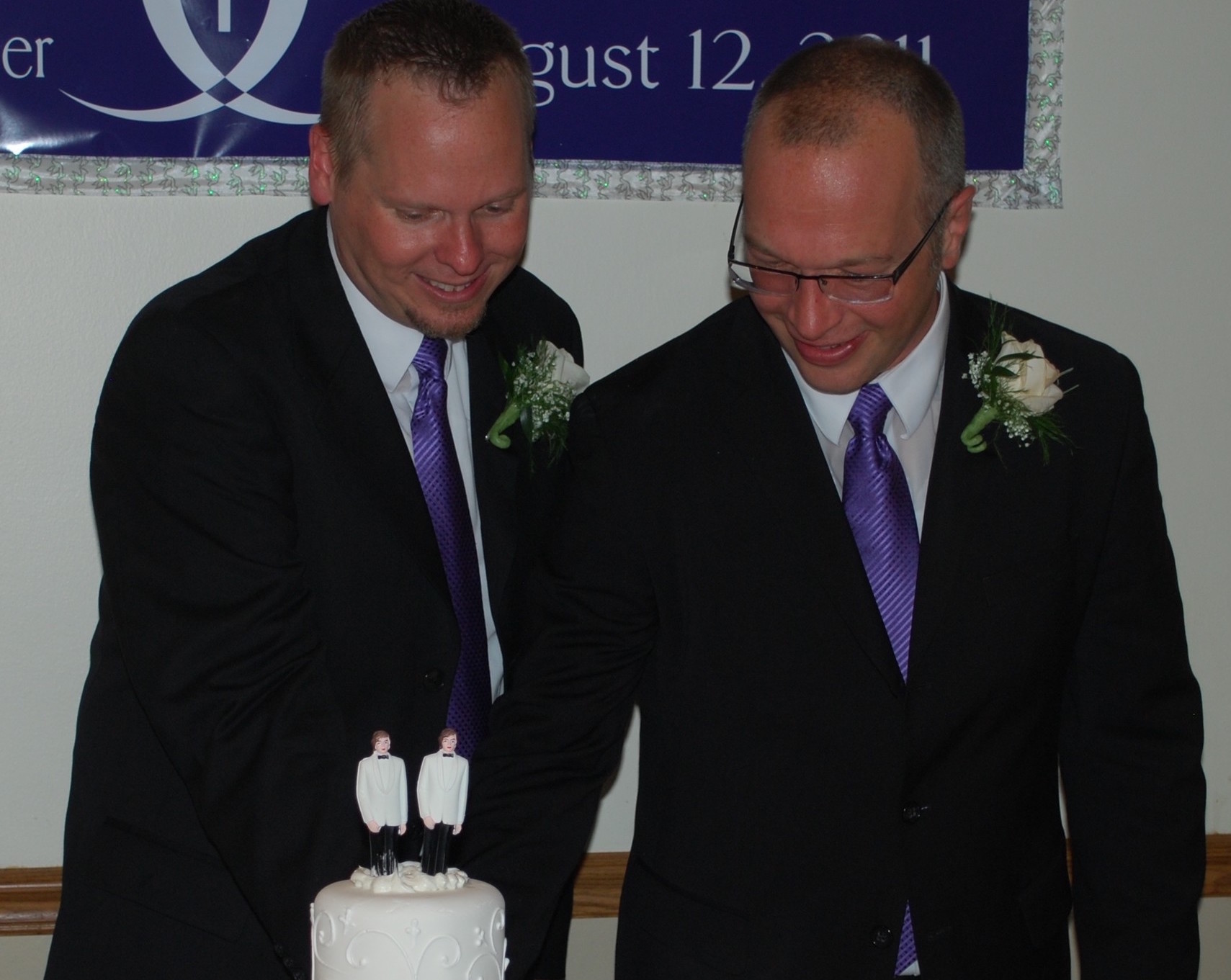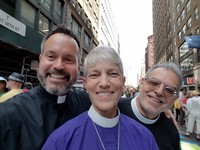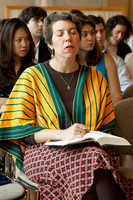During Pride Month, LGBT clergy reflect

“Oh, there goes Father Faggot.”
The Rev. Christopher Hofer still recalls the insults children and teens hurled at him in 2004, while he was out running in Wantagh, his new neighborhood. He had just been named the rector of the Church of St. Jude. But before he accepted the position, he said, he had to answer many questions about how the fact that he was openly gay would affect the congregation.
Hofer, who is now also the vicar of St. Michael and All Angels in Seaford, noted that congregants did leave St. Jude when he was hired. But seven years later, hundreds of parishioners old and new packed the Episcopal church, on Lufberry Avenue, to watch Hofer marry his longtime partner, Kerry Brady.
Following Episcopal tradition, the Rev. Debra Bennett bound Hofer’s and Brady’s hands and said, “Those whom God has joined together, let no one put asunder.” She then told the misty-eyed couple to turn around to see that everyone in the room was on their feet, applauding.
“Early on here in Wantagh, it was difficult,” Hofer said. “But the attitudes of our neighbors have changed over the years. It was always important to us to be authentically who we are. For me, I am a priest, and I happen to be married to a man.”
Hofer and some of Long Island’s other openly gay spiritual leaders took part in recent Pride Month festivities in Long Beach and New York City. And like Hofer, some of them said that their personal and spiritual journeys for acceptance in LGBT, faith and local communities continue.
Finding a home
Hofer, 46, moved to different states across the Midwest when he was young — Wisconsin, Indiana, Illinois and South Dakota — with his mother, Cathy, and his father, David, a Lutheran pastor. Laughing and noting that he never chose a girlfriend in his kindergarten class, he said he always knew that he was different.
Coming out was unimaginable to a young man who was already bullied in school, who hadn’t met another openly gay person and who was taught at church and by his parents that being homosexual was an abomination. “I thought that I was the only person like me in the world,” Hofer said.
He told his mother that he was gay in 1994, when he was a 23-year-old graduate student. He never formally came out to his father.
Cathy Hofer had two fears for her son, he concluded: that he would contract HIV, as scores of gay men did during the AIDS crisis of the 1980s and early 90s; and that, based on her understanding of scripture, he was committing a sin. Hofer said he did not feel welcome in a house of worship again until he found the Church of Our Saviour, an Episcopal church in Akron, Ohio. He converted in 1995.
“I understood for the first time that God really did love me unconditionally and that I wasn’t some evil, demonic human for being gay,” he said. “If God could love me, and people in church could love me, then why couldn’t I love myself? When those three elements came into play, the floodgates were opened.”
The Rev. Michael Delaney, canon pastor of the Cathedral of the Incarnation in Garden City, said that the Episcopal Church has always been open and welcoming. The first openly gay bishop was consecrated in 2003. In 2009, the General Convention of the Episcopal Church resolved, “God’s call is open to all.”
Delaney, 60, was a Roman Catholic until he was ordained in the Episcopal Church in 1998. Before he converted, he was an Augustinian monk for 14 years.
While he said that he always felt welcome, safe and secure in Catholic churches, he knew he could not be ordained because he was openly gay. Homosexual acts, according to the Vatican website, are viewed as “contrary to the natural law. They close the sexual act to the gift of life.”
“There was a time in the Catholic church in which certain pronouncements were made, and I found myself thinking deeply about my involvement in that church and what it meant for me to fight from the inside,” Delaney said. “I didn’t think that that was a battle that I could win. I had to bite the bullet and leave something that I loved and treasured, that was very formational and foundational.”
Rabbi Lina Zerbarini, the director of the Weinberger Center for Jewish Life and Learning at the Sid Jacobson Jewish Community Center in East Hills, was also raised Catholic. Zerbarini, a 50-year-old Lynbrook resident, said she read a Bible that she had asked for for Christmas, cover to cover, when she was in fifth grade, and found herself relating to the people described in the Old Testament, or the Torah, because they were flawed and human.
Zerbarini said that her parents were more accepting of her converting to Judaism than they were of her coming out as a lesbian in 1986. Five years later she enrolled in the Reconstructionist Rabbinical College — which became the first major rabbinical seminary to accept openly gay students in 1984 — after working at the Larkin Street Youth Center in San Francisco.
“I was working with a lot of gay kids who were on the streets — kids who were using drugs who were very much at risk for HIV,” Zerbarini said. “It was amazing, powerful, important, inspiring and deeply learning work for me. I felt like I was doing that work on a sense of mission and values — what I felt like were Jewish values.”
‘A gradual process’
Zerbarini said she helps others “harness the wisdom and tools of Jewish history and tradition to help others’ lives today” through her role at Sid Jacobson, the only full-service JCC on the North Shore. While she feels at home there, she noted that not everyone is welcoming and accepting of her and other LGBT people across the country.
Describing the differences between liberal and conservative worlds, Zerbarini noted that queer kids are still being bullied, and that the suicide rate of LGBT youth is significantly higher than that of the general population. But it is important, she said, for people in religious communities, and other communities, to find ways to start dialogues about their differences.
“I don’t find it easy to talk to people who, from my perspective, deny my humanity,” she said. “It’s painful. But I don’t think it does us any good to retreat into our separate camps.”
Delaney said that different churches continue to interpret the same religious texts in different ways, leading to a range of opinions. He pointed out that a line in the Christian Bible often used by evangelicals to denounce homosexuality — “If a man also lie with mankind, as he lieth with a woman, both of them have committed an abomination” — is used as a “text of terror.”
“In the same list, there are lines about not cutting sideburns and not wearing combinations of fabric that aren’t natural,” Delaney said, laughing, then added, “Although I think that no one should wear polyester, I’m not going to take that one phrase and call it a sin. [Episcopals] believe that the word of God is living and active, and that we have the ability to interpret it in this time and in this place.”
Delaney said it is important to him to be visible and show others that some churches welcome gay people like him. That’s why he always wears his collar at the New York City Pride Parade, and why he sits on the LGBTQ and Allies Committee at Adelphi University. At the college, he said, he talks to students who are wrestling with their sexual identity — one that might have been condemned by their church.
Both Delaney and Hofer noted that LGBT people might also distrust priests or people of faith because of some churches’ denunciations of them. Delaney said that when he ran for a seat on the board of the New York City Gay Men’s Chorus in 1991, members questioned how he could work for the Catholic Church, which they described as oppressive. He also said that he worked with many people who were deeply hurt by their churches when he was a chaplain at Gay Men’s Health Crisis in New York City.
Hofer said he could relate to people who are peeling off years of painful memories of oppression. As a clergy member, he said, he has always tried to create a community in which people may realize that they can be both spiritual and queer.
“It’s a gradual process,” he said. “Many don’t want to go through it, and that’s OK. Those who are seeking and questioning will discover that God does love them.”

 45.0°,
Partly Cloudy
45.0°,
Partly Cloudy 







